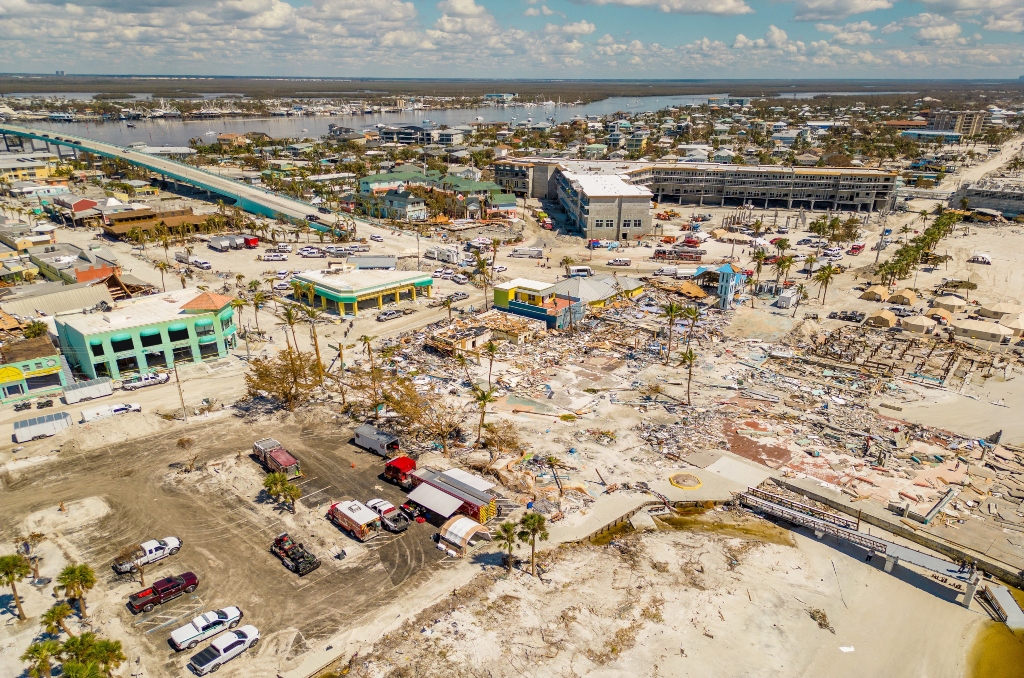Aftermath of Hurricane Ian — Courtesy: Shutterstock — Felix Mizioznikov
Florida is known for its incredible wildlife, from the birds that fly high in the sky to the beasts that roam through the swamps and gorgeous beaches.
However, Florida’s beauty sometimes gets brutally interrupted, just as it did last month when Hurricane Ian rammed into Southwest Florida as a catastrophic Category 5 storm.
This region of the Sunshine State has arguably the most unique array of wildlife, ranging from the invasive Burmese python to the endangered Florida panther. Now the plants and tree canapes are all twisted, brown, torn apart, and ripped.
So what exactly happened to all of the animals?
Some, like sharks, might have completely left the area before Ian reached landfall. As Ian drew water from the rivers and bays, other animals, including manatees, might have become stranded.
The good news is that these creatures have evolved over thousands of years to withstand the effects of hurricanes and tropical storms, according to scientists.
Certain species give birth to young several times a year. In this manner, if a storm occurs, another cycle of young will still exist throughout the same year.
Following previous hurricanes, scientists have seen the following, along with predictions regarding Ian’s probable effects:
Dolphins and sharks often flee
Tagged sharks from Sarasota south to San Carlos Bay abandoned the Southwest Florida coast around 24 hours before Hurricane Charley landed in 2004. The data depicted that the same sharks made it back nearly 24 hours after Charley hit.
“The sharks left just before the storm hit and then came back just after,” said Jim Beever, a former state fish and wildlife biologist.
University of Miami researchers found a similar response in sharks.
West Indian manatees face stranding
Thousands of these threatened and gentle herbivores live by Florida’s shallow waters, however, they can get stuck and severely injured during stronger storms.
Stephanie Kettle, spokeswoman for Mote Marine Laboratory and Aquarium in Sarasota, said that “no Ian-related strandings have been reported in the Sarasota and Fort Myers areas.” But Kettle did notice that with Hurricane Irma in 2017, for example, “Tampa Bay emptied out and sometimes manatees get left out like that.”
Sea turtle eggs buried
Large hurricanes can cause storm surges of up to 15 feet, which can overwhelm the barrier islands where several species of sea turtles nest.
This inundates the nests and annihilates any potential hatchlings buried in the sand. However, the effects can change depending on which time of year the storm occurs.
“Luckily, we were at the tale end of sea turtle nesting season,” Kettle said. “We only had about 100 nests left in an area of 35 miles that we monitor. And about 10 to 15 of those got washed out. So in terms of it coming at the end of the season, it’s better than July, when we would have 1,000 nests.”
Throughout the summer, which is coincidently hurricane season, female sea turtles lay their eggs multiple times. The turtles have adapted by creating many nests in cycles, which has helped to increase their chances of survival.
“A lot of these species have been nesting in Florida and dealing with hurricanes and big storms as long as they’ve been around,” Kettle said. “That’s part of their reproductive strategy, to produce three or four times in a year, so that if one gets hit then there’s another period of time to lay eggs. That combats the natural threats.”
Are you interested in Florida’s nature? For stories like this and much more: Florida Insider is dedicated to educating, entertaining and informing its readers about everything Florida. Easy to read content at the palm of your hands and covering the stories that matter.
Melissa’s career in writing started more than 20 years ago. Today, she lives in South Florida with her husband and two boys.

